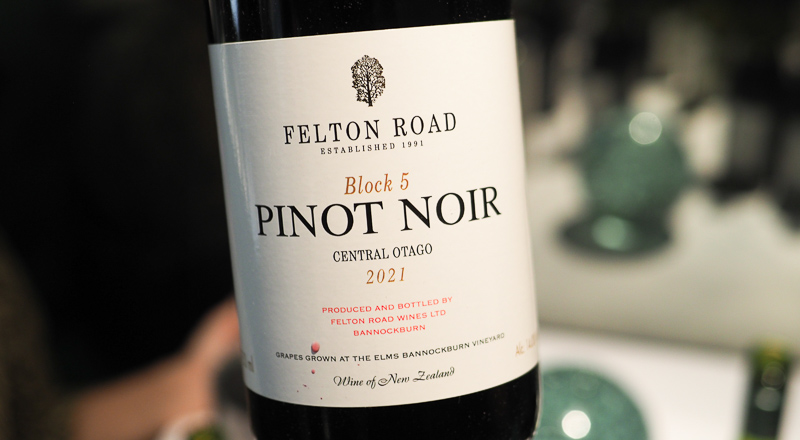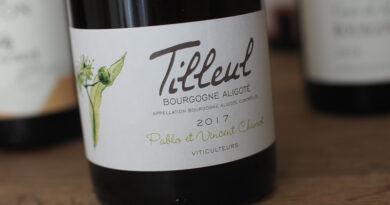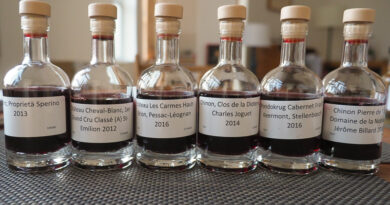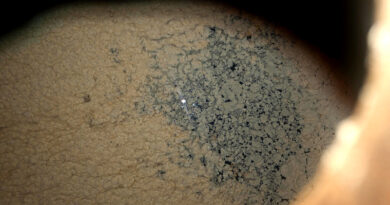Felton Road: current releases and a retrospective, celebrating 25 years of this important Central Otago producer
It’s easy to forget how recent Central Otago’s progress as a world famous wine region is. When the first blocks of the Elms vineyard (Felton Road’s home site) were planted in 1992, together with some plantings by Olssens that year, it doubled the area under vine in the region from 11 to 22 hectares. This is a new wine region.
So it was special to be able to taste a retrospective of Felton Road’s wines spanning back 25 years. Going back in time to almost the beginning of the wine region, and then seeing how things have changed is really instructive.
Some history. Stuart Elms began Felton Road in the early 1990s. As a 50 year old, after a first career as a blackcurrant farmer, he went to wine school at Lincoln University and then bought the land in Bannockburn, Central Otago, that was then to become the Elms Vineyard, and planted the first vines in 1992. This was very early days in the Central Otago story, and he was a pioneer in this subdistrict. The first harvests (1995 and 1996) were sold to Gibbston Valley, but in 1996 he hired Blair Walter as a winemaker and the 1997 vintage was to become the first official vintage of Felton Road, hence this gathering celebrating 25 years of this leading Central Otago winery. Blair has overseen all 25 of these vintages.

But there’s a twist to the story: the 1995 Felton Road exists, and we tried it here, thanks to Mimi Avery who’d bought it with her. English wine merchant Christopher Fielden had been in the region when the grapes from this first harvest were picked, and he persuaded Grant Taylor at Gibbston Valley to keep two hogsheads aside and bottle them. So this was the unofficial debut vintage, and it was thrilling to be able to taste it.
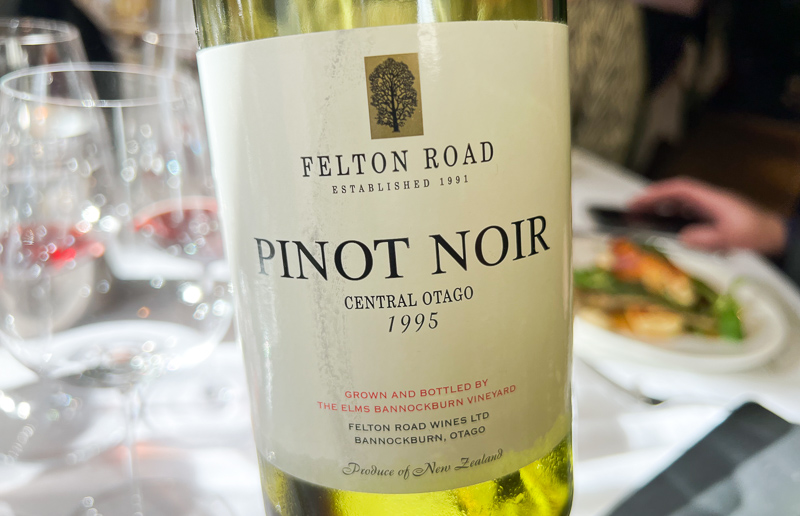
Felton Road is inextricably linked with its current owner Nigel Greening, who has been its custodian for 22 these 25 years. After selling his business in the UK he spent time in New Zealand, and as a wine geek a bit ahead of the curve he’d taken an interest in New Zealand Pinot Noir, and particularly the embryonic wine region of Central Otago that seemed to have potential for this variety. He bought a promising patch of land that was at the time an 8.6 hectare apricot orchard called Cornish Point, in 1999, with a view to planting vines. ‘I bought it because the local farmers’ wives all said the Cornish Point apricots were the best-tasting apricots in the region. It’s a fairly good blind indicator. Fruit is fruit.’ Before planting this site to vines he invited the entire community to come and take anything they wanted to dig up. And then anything was left, was given to the local Rotary and Lion’s clubs who could come in and take firewood.’

Cornish Point vineyard is beautifully situated just across the water from the town of Cromwell. It’s a spit of land sticking out into Lake Dunstan, and its 8.6 hectares are split into 25 different blocks, with 18 combinations of rootstocks and clones of Pinot Noir. Cornish Point Pinot Noir was released under its own label from 2003–2006, but from 2007 this has been a single-vineyard Felton Road wine. It’s also an important component of the Bannockburn bottling.
Then Nigel heard that the Elms project was potentially for sale. He’d already bought quite a bit of the 1998 and 1999 vintages of Felton Road, and jumped in, buying the vineyard in 2000. It was 9 hectares at the time, and since he’s grown this Elms Vineyard to 14.6 hectares. Elms was planted over two phases (blocks 1–9 1992–1994 and 10–13 in 2001). There are currently 8.1 ha of Pinot Noir, 4.1 ha of Chardonnay and 2.2 ha of Riesling, all matched to the specific soil types that best suit each variety.

‘When I bought Felton Road, they had about 8 or 9 hectares of vines,’ says Nigel. ‘I had Cornish Point which was going to be planted to about 7 hectares. I knew that this hectarage was not commercially viable between the two of them. We knew it was too small and the first day I bought it, Blair and I had lunch together to chat about the future. I’d said to him, clearly we are going to have to grow: what do you think is the right size from a winemaking point of view. He thought about it for about 10 minutes and said 400 barrels. After that I’m a winemaker on a laptop. We did the maths and this was a 200 ton winery, with roughly 30 hectares of vineyard. We looked at what we could sell the wine for with a good following wind, and could that add up. It looked to be viable. We got to this figure in 2006. We are still at that figure and we will never grow.’

Nigel recalls the early days, where they had some good fortune. ‘We needed land, and we needed vineyards, and we needed it quite quickly. Otherwise we would go down a hill of not having enough revenue to pay people. We identified, just across the road, a 4.5 hectare vineyard in Bannockburn belonging to a Frenchman called Yves Montagne. He planted it and got bored, and now lives in Vanuatu. I went to see the person who managed it and they said, you can have that vineyard, we’ll lease it to you, but you have to take this other vineyard in the Gibbston Valley, which was about 12 hectares. We didn’t really like the Gibbston Valley, but it was this or we couldn’t have it [the Bannockburn Vineyard they called the Sluicings and is now owned by Burn Cottage and is called the Sauvage vineyard]. And we had to buy the wine he’d not been able to sell that was in clean skin and 40 barrels of wine lying in Mount Difficulty that were made for him. We thought about it, and said, come one, we need the land. So I signed up. I inherit this clean-skin wine, the wine in barrel, and a vineyard of 12 hectares that we didn’t really want. But we were extraordinarily lucky because we had this vineyard called Cornish Point, and we created a label that was not Cornish Point Vineyard, but just the brand name Cornish Point. I had to do this to protect the trademark for the future. There was someone down the road at Bald Hills who was thinking about calling their wine Cornish Point. We created a series of cuvees from this until 2005: first the clean skin wine, then the wine at Mount Difficulty, both of which we pushed out fast. Then the wines that Blair started making from the Gibbston Valley site were called Cornish Point. We used to sell these to both John [Avery] and Bill [Baker]. The nice story is that first time we ever did this, in 2001, I bought samples. I landed at Heathrow, got in my car, and drove down towards the West Country where I lived. First I stopped at John’s and said I have some wine to show you. He tasted it and said it’s really great, and the price was fair, but it wasn’t a bargain, and he said I’ll take 250 dozen of that. I got back in my car and went down the road to Bill’s. The first thing he said, that’s nice, and are you hungry? So he came back with a large plate of roast beef, and put a large glass of red wine in front of me. I tasted it and said, that’s nice Bill, and he said I can’t remember the vintage but it’s Richebourg. I said, you shouldn’t have done that. He said, nonsense, it’s The Wine Society: it cost me less than the stuff I buy from you. He tasted my wine and said I’ll have 125 dozen, please. That was almost two-thirds of the production I’d sold. I got home and there’s a message to call Bill. He said, I’ve been thinking, make it 250 dozen. I’d sold the entire vintage in the car from the airport to home.’

‘We stepped out of that vineyard when we got our own land. We managed to sell the lease for $250 000 to a Californian man. We were lucky with vintages: Gibbston is like that. We had a run of warm years and as soon as we sold it it went through two or three cold years. At that point we were at critical mass and we could keep our chin above water. By 2006 we were at our 200 tons at land we had long term leases on, and in due course we turned those long term leases to ownership. The only change we have made is with spare little bits of land to increase the planted vines to 33.7 hectares, largely because we do have phylloxera and ungrafted vines in a couple of the vineyards, so we need a bit of wriggle room.’
Subsequent additions to the vineyard holdings include Calvert, which is a gently sloping, north facing vineyard first planted in 1999, with two more planting phases in 2001 and 2003. The soils are deep silt loams, with moderately high fertility. The vineyard is quite consistent, and because it is a bit lower down than the Elms, it ripens sooner. Interestingly, the fruit from this leased vineyard, managed by the Felton Road team, has for a number of years it was split three ways, with Calvert wines also being made by Craggy Range and Pyramid Valley Vineyards. The three different wines that resulted were an interesting case study in how three excellent wineries each imprint their own stylistic influences on grapes from the same site. Does the terroir come through in the wines, or is winemaking the overriding influence? But a while back Calvert was put up for sale, with Felton Road taking the three Pinot Noir blocks Willows, Aurum and Springs, and Cloudy Bay taking the rest.
Felton also acquired a new site, MacMuir, which is next to Calvert and which they planted in 2013 with Pinot Noir. It’s another 5.8 hectares, bringing the total vine area they own to around 33 hectares in total.
One of the themes of the retrospective was dividing the story of Felton Road into too eras, with the 2011 vintage as the pivot point where they realised that they could pick earlier and do less to the wines in the cellar. So 2012 is seen as the first vintage of the new era: one of more precision and focus.
‘We regard 2012 as being a kind of renaissance,’ he says. ‘2011 sealed it for us. It was a vintage that was all going fine, and as we came up to harvest the grapes started losing all their life and we thought we had to get them off. We hauled them in early and thought it was a weak vintage, but when we tasted the wines we liked it more. We thought all this hang time thing might be nonsense,’ says Nigel. ‘So Felton Road lives in these two halves.’ He says that the pre-2012 Pinots had a slight stewed character that he can’t get past.
‘From 2012 onwards we increased the picking teams, until they were twice the size they used to be,’ says Nigel. ‘Whereas we used to pick over three to three-and-a-half weeks we now pick in 11-12 days. This whole thing of getting behind and picking the second half too late is what we were attacking. It is not our start point: just that everything has to come in the earliest day it can.’
As a result of this earlier picking, the alcohols have gone down a little, but not much. ‘The issues with [later picking] tended to be just that sweeter overblown fruit style,’ says Nigel. ‘We have lost about half a percent of alcohol.’
‘What we tend to show from the old school now are the weaker vintages. This is because they were the ones where the ripeness was a bit lower anyway. At the time we thought, this will be weak, but in our current mood we like them.’
In terms of winemaking changes, ‘It’s the same as everybody,’ says Nigel. ‘Everybody has pulled back a little on oak, and pulled back on punch downs. We are just a little more gentle. But the percentage whole bunch hasn’t really shifted: that’s been the same from the start. The overall pattern is about 5 days cold soak to let the wild ferment develop some interest, and we kick it off by warmth rather than adding yeast. There’s a total of 18-20 days on skins before pressing off. The only other difference is that it used to be an 11 month cycle for some of the wines so we could turn barrels. About 5 years ago Blair said I think it needs to be 13 months. That does mean a new barrel cellar for storage of 400 barrels. And so now we do 13-14 months for what we call the fluffy soil wines (Bannockburn, Block 3, Cornish Point and McMuir), and then still pushing out to 18 months for Calvert and Block 5.’
THE WINES
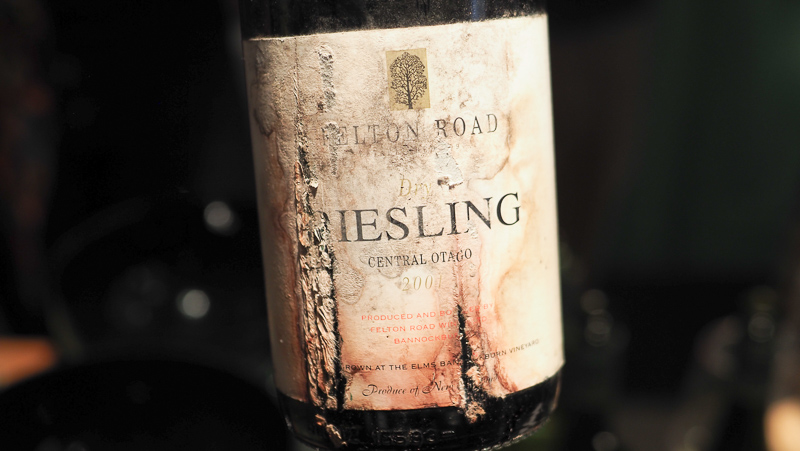
Riesling
The Rieslings were a real surprise. How well the early threesome have developed! I think I’ve under-rated these in the past.
Felton Road Riesling 2001
Under cork. This is lively and intense, and pure, mineral and salty. Has some honeyed notes, but also some savoury freshness. Brilliant focus here: crystalline and still youthful. 94/100
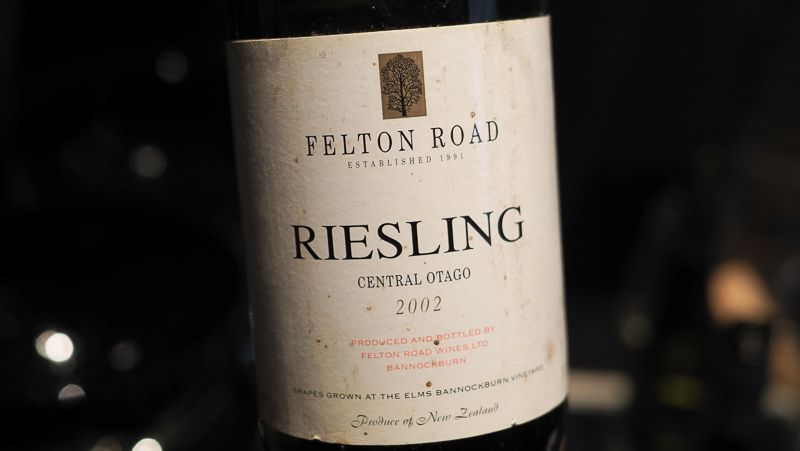
Felton Road Riesling 2002
Crystalline and fine with lovely lime and honey and spice notes. Youthful with good concentration and a hint of sweetness. Saline and precise. 95/100
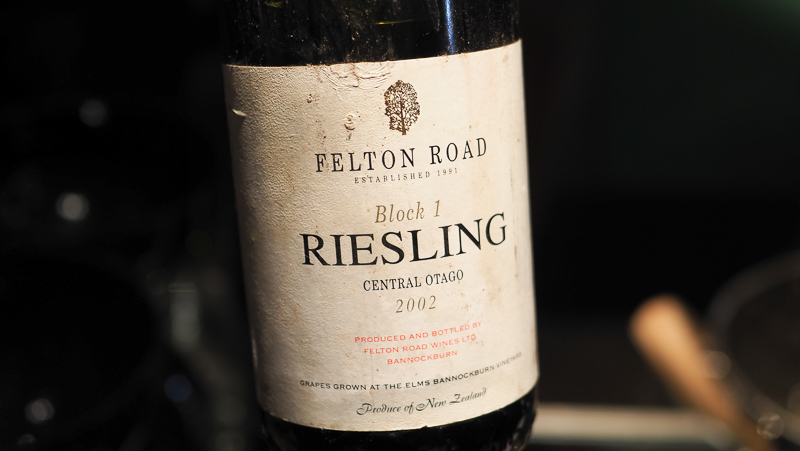
Felton Road Block 1 Riesling 2002
Intense and vivid with lime, marmalade and mineral characters. Pure with a lovely acid line, showing finesse and purity. There’s also some salinity here: this is quite profound. 96/100
Felton Road Dry Riesling 2021
Taut, mineral and very tight with fresh fruit and good precision. This is fine and expressive with pithy citrus fruit. 94/100
Felton Road Bannockburn Riesling 2021
Off-dry and concentrated with some bright floral characters and a mineral streak. Lovely citrus fruit. This is showing amazing precision with almost perfect balance. 95/100
Felton Road Block 1 Riesling 2021
Textural and concentrated with sweet, smooth pear and citrus fruit, with a lovely linear, mineral fruity core. This has depth and refinement. 95/100
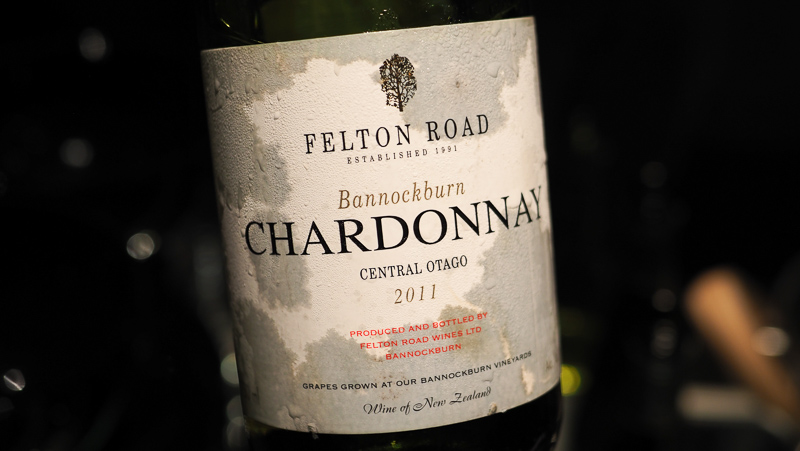
Chardonnay
Felton Road Chardonnay 2002
Mature with toast, honey and nuts, as well as fine spices. There is some development with a touch of cheese, too. Interesting stuff. 93/100
Felton Road Barrel Fermented Chardonnay 2002
Complex nose of nuts, spice, honey and minerals. On the palate this has a strongly savoury quality, with hints of cherry and marzipan. 93/100
Felton Road Elms Chardonnay 2011
Linear, taut, mineral and fine, with a subtle creamy edge to the citrus fruit. Quite fresh and focused with a stony edge. Such precision here. 94/100
Felton Road Bannockburn Chardonnay 2011
Juicy and linear. Very precise with pure citrus fruit, some pear, and a touch of toast. There’s some spicy savouriness, too. Lovely purity and precision.
Felton Road Chardonnay 2012
Lively and limey with intensity, and a hint of pineapple. Lovely pure fruit here, showing drive and precision. Supple and expressive with good concentration and purity. 94/100
Felton Road Block 2 Chardonnay 2012
Concentrated with nice density. Mineral with pure citrus, pear and pineapple fruit showing appealing stony and mandarin hints. Still very pure and linear, with structure. 94/100
Felton Road Bannockburn Chardonnay 2021
Linear and fresh with pear and citrus, as well as a touch of pithiness. Compact, showing nice balance, with a mineral core. 93/100
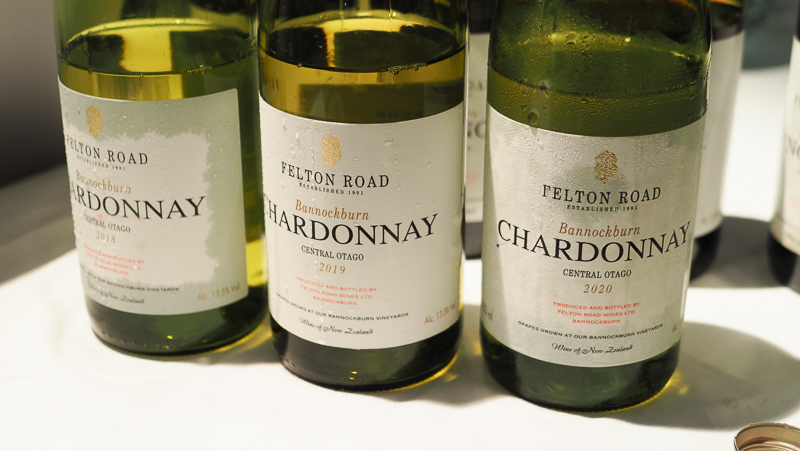
Felton Road Block 2 Chardonnay 2021
Fresh and supple with nice precision. Shows a mineral edge to the restrained citrus fruit. Pear and citrus with some stony minerality. 94/100
Felton Road Block 6 Chardonnay
Crystalline with a hint of mandarin, and notes of lime and grapefruit. There’s a lovely mineral undertone here: this is very fine. 95/100
Felton Road Bannockburn Chardonnay 2020
Very precise and pure. Light with lovely lime notes and some pear and apple, as well as fine toasty hints. This has an appealing crystalline quality – so fine and delicate. 95/100
Felton Road Bannockburn Chardonnay 2019
Powerful and linear with notes of toast, honey, lime and a hint of pineapple. Good precision with nice acidity and a touch of lime on the finish. 94/100
Felton Road Bannockburn Chardonnay 2018
Concentrated and lively with rich, pure pineapple, mandarin and lime fruit. Great acidity here. 94/100
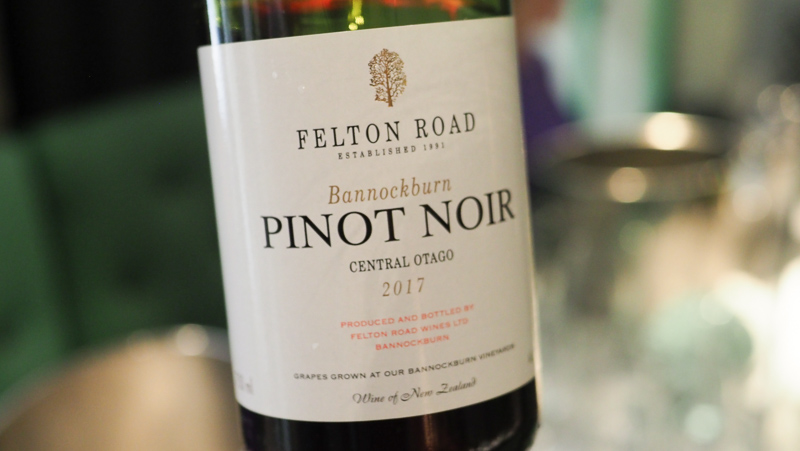
Pinot Noir
Felton Road Bannockburn Pinot Noir 2017 Central Otago, New Zealand
Lovely aromatics with some fine spicy notes, iodine and minerals, and dried herbs. Sweet fruit here on the elegant palate with supple red cherries and some lovely spicy warmth. Very smooth and fine with a mellow complexity. Fine grained and drinking beautifully now. 95/100
Felton Road Bannockburn Pinot Noir 2018 Central Otago, New Zealand
Concentrated, fine and quite refined with sweet cherries and plum notes. Lovely red cherry and strawberry fruit. Has some softness and it’s mellow and quite mature, echoing the warm vintage. 93/100
Felton Road Bannockburn Pinot Noir 2019 Central Otago, New Zealand
Juicy, bright and vivid with sweet red cherries and plums as well as vibrant raspberry notes. Lovely freshness and intensity here with a slight saline twist. Nice grip. 94/100
Felton Road Bannockburn Pinot Noir 2020 Central Otago, New Zealand
Some spicy reductive hints here with fresh raspberry and cherry notes. There’s a sappy cranberry character. Juicy and fine. 93/100
Felton Road Bannockburn Pinot Noir 2021 Central Otago, New Zealand
Bright, juicy and linear with pure, supple red cherry and raspberry notes with a spicy bite. Has lovely taut red fruits with a bit of crunch. Vibrant, with a youthful, slightly reductive character. 94/100
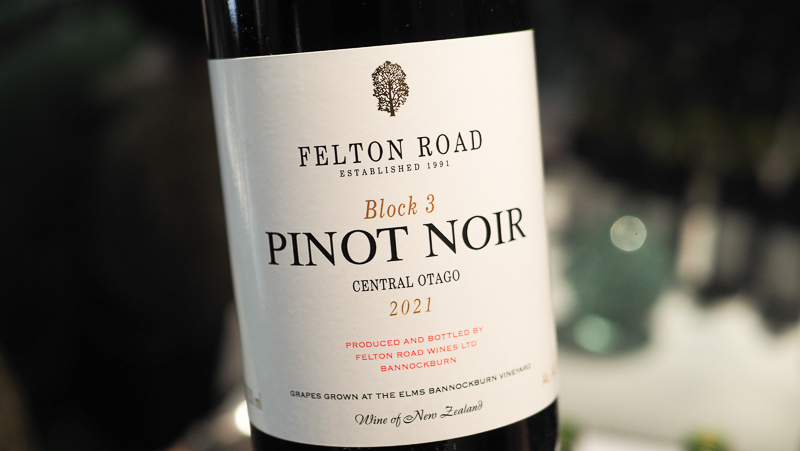
Felton Road Block 3 Pinot Noir 2021 Central Otago, New Zealand
Supple, showing a silky elegance with sweet raspberry and cherry fruit, as well as some marzipan and aniseed. Lovely supple, juicy red cherries and redcurrants with a nice stony edge. 95/100
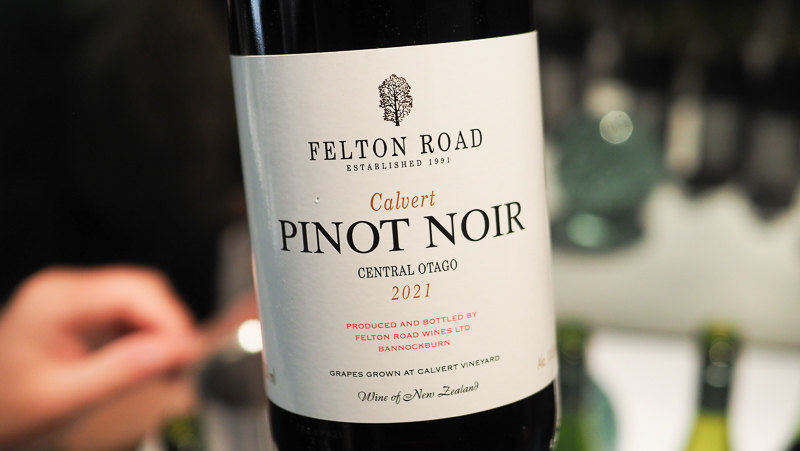
Felton Road Calvert Pinot Noir 2021 Central Otago, New Zealand
Really elegant, showing light, fresh pure red cherry fruit with some raspberry brightness and a sour cherry edge. Supple and fine with lovely elegance. 95/100
Felton Road Block 5 Pinot Noir 2021 Central Otago, New Zealand
Nice flesh here: ripe and sweetly fruited with elegant redcurrant and cherry fruit as well as some sappy notes. Lovely structure: this is so precise and fine with concentration, texture, structure and purity. 97/100
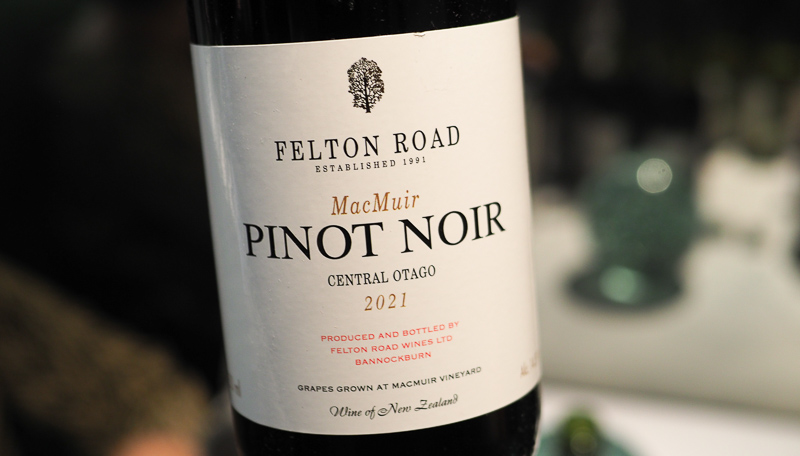
Felton Road MacMuir Pinot Noir 2021 Central Otago, New Zealand
Ripe, sweet and compact with smooth, silky cherry fruit and a hint of spicy reduction framing the substantial ripe fruit. Has a lovely iodine and aniseed edge. Opulent and fine. 96/100
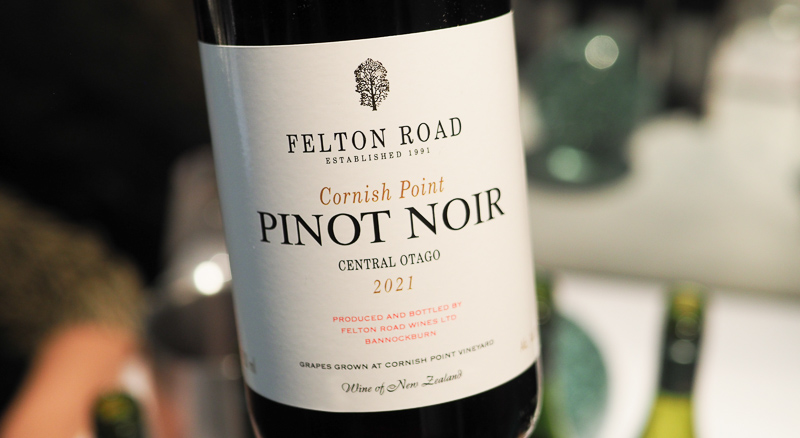
Felton Road Cornish Point Pinot Noir 2021 Central Otago, New Zealand
Rich, concentrated and taut. Refined with sweet cherry fruit at its core, and nice grip. Firm with good weight and nice structure, as well as the sweet fruit. 95/100
Felton Road Block 5 Pinot Noir 2008 Central Otago, New Zealand
A heavily cropped vintage which kept the ripeness down. Concentrated and sweetly fruited with some meat and spice notes. Lovely texture, and some notes of soy sauce. This is silky but there’s also some savoury detail. 93/100
Felton Road Block 3 Pinot Noir 2009 Central Otago, New Zealand
Rounded, supple and sweetly fruited with a rich texture. Raspberry and red cherry notes. Has a sense of luxury with nice intensity and textural detail. Real elegance and purity here. 94/100
Felton Road Pinot Noir 1995 Central Otago, New Zealand
This is the unicorn bottling. The first vintage off the Elms vineyard, which was destined for Gibbston Valley’s reserve wine that year, but Christopher Fielden convinced winemaker Grant Taylor to keep two hogsheads separate, and bottle them as Felton Road. This is malty and mature with some olive, meat and spice notes. It still has some fruit, with savoury, spicy detail to the orange peel, dried herbs and red cherry fruit. So interesting to taste this! 92/100
Felton Road Cornish Point Pinot Noir 2014 Central Otago, New Zealand
Felton Road Cornish Point Pinot Noir 2014 Central Otago, New Zealand
This is Nigel’s personal favourite. Sweetly aromatic red cherries, spice and iodine, as well as dried herbs on the nose. The palate is very fine and textural with hints of tar and spice. Showing some development, this is very textural, but still has some freshness. 95/100
Felton Road Calvert Pinot Noir 2015 Central Otago, New Zealand
Lovely fruit here: red cherries and raspberries with some fine, silky texture. Expressive with nice presence and weight, and a primary fruit quality. Such presence here. 96/100
Felton Road Bannockburn Pinot Noir 2012 Central Otago, New Zealand
Supple and bright with red cherries and plums. Iodine, spice and some nice mineral notes. Taut, fine and savoury with beautiful fruit. Nice savouriness. 94/100
Find these wines with wine-searcher.com

